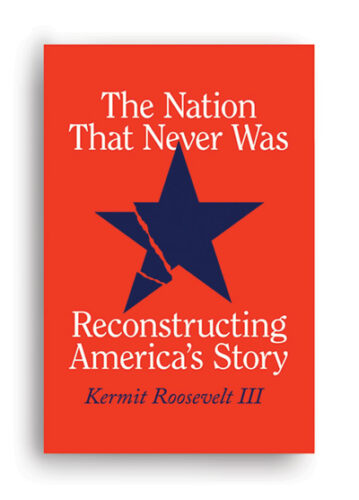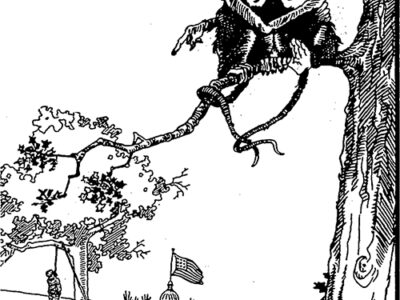Kermit Roosevelt launches a provocative interpretation of the Declaration of Independence.
By Julia M. Klein

The Nation That Never Was: Reconstructing America’s Story
By Kermit Roosevelt III
University of Chicago Press, $25
We all know the Declaration of Independence’s most famous line: “All men are created equal.” That statement has long formed the basis of America’s story about itself—a narrative celebrating the ideals of the Founders, admitting ways the country has fallen short, and emphasizing the gradual expansion of the American promise.
But what if that line never meant what we’ve come to think it did?
That question animates Kermit Roosevelt III’s well-argued polemic, The Nation That Never Was: Reconstructing America’s Story (University of Chicago Press).
Roosevelt, the David Berger Professor for the Administration of Justice at Penn Law and a former law clerk to US Supreme Court Justice David Souter, has an unusually intimate connection to American political history. He is the great-great-grandson of President Theodore Roosevelt and a distant cousin of President Franklin D. Roosevelt. His 2015 historical thriller, Allegiance, took aim at one of FDR’s most criticized actions: the internment of thousands of Japanese Americans, including American citizens, during World War II [“That Roosevelt,” Mar|Apr 2016].
The Nation That Never Was is similarly concerned with the American community’s insiders and outsiders. But it focuses almost entirely on slavery, segregation, and other manifestations of anti-Black racism. (The oppression of Asian Americans, other ethnic groups, and sexual minorities scarcely merits a mention. The longtime exclusion of women from suffrage is noted, but no more. Other aspects of women’s struggle for full legal equality with men—including reproductive rights—aren’t covered at all.)
In both his adoption of the rhetoric of anti-racism and his sympathy for the New York Times’s controversial 1619 Project, which insists on slavery’s centrality to US history, Roosevelt is in tune with prevailing ideological currents.
His argument is nuanced and, at times, complex. But it can be summarized simply. Americans, he says, have been taught specific readings of the Declaration of Independence, the American Revolution, and what he calls the Founders’ Constitution. But that “standard story,” he maintains, is neither accurate nor useful. In fact, its distortion of the past has been downright harmful.
“The truth is that racism is not a superficial aspect of America but a cancer that has metastasized throughout the body,” Roosevelt writes. “The truth is that it explains much more of American life and American history than we want to admit.”
Instead of emphasizing continuity, he suggests, we would be better off accepting an explicit rupture in the American narrative. “We are more properly the heirs of the people who destroyed [the Founders’] regime,” Roosevelt writes. That realization, he contends, would place us on firmer historical ground—and provide a stronger basis for creating a more inclusive America.
Roosevelt locates the ideological roots of contemporary America in President Abraham Lincoln’s Gettysburg Address and the three Reconstruction amendments, which abolished slavery, made Black Americans citizens, and awarded voting rights to Black men (though neither Black nor white women). Black military service, Roosevelt argues, helped secure Black citizenship. And the Fourteenth Amendment, with its guarantees of “due process” and “equal protection” under law, has become a critical piece of constitutional infrastructure, used to expand rights for a range of traditional outsiders.
The standard story, in Roosevelt’s view, posits that equality and liberty were always at the core of American beliefs. It regards slavery—and, by extension, other forms of oppression and discrimination—as an aberration, destined to be corrected gradually over time. According to this argument, the Revolution was fought for ideals enshrined in the Declaration of Independence. And the Constitution, albeit an imperfect compromise jerry-rigged to satisfy Southern states, was the vehicle that codified those ideals.
Roosevelt criticizes the “triumphalist” version of US history but also faults some revisionists for recapitulating part of it.
The triumphalist version emphasizes the constant progress of America towards fulfilling its ideals. That version has been “eroded,” Roosevelt says, by revisionist narratives like the 1619 Project that focus on impediments to equality. These revisionists critique the Revolution, the Constitution, and the Founders themselves. Yet they continue to turn to the Declaration of Independence as a source of inspiration.
But Thomas Jefferson’s notion of equality, he argues, had nothing to do with government-secured equality under law. That sort of equality didn’t exist in the colonies, which permitted slavery. Nor did it exist elsewhere in the 18th-century world. And it certainly wasn’t a “self-evident” truth to slaveholders such as Jefferson.
In fact, the Declaration, rooted in Enlightenment political philosophy, “is not about rights at all; it is about independence,” Roosevelt writes. When Jefferson says, “all men are created equal,” Roosevelt contends that he is imagining a hypothetical state of nature, in which no human being is created to be a king, let alone a tyrant.
The Declaration’s intent is to define when it is appropriate for a people to withdraw consent from a government. The answer, Jefferson avers, is when that government fails to ensure the rights it was formed to protect. But the only people whose rights matter in this argument, Roosevelt says, are political insiders—not outsiders such as enslaved people or Native Americans.
Like many scholars before him, Roosevelt sees the Constitution, before the Reconstruction amendments, as both compatible with slavery and protective of it. Where he differs is in maintaining that it doesn’t, in fact, contravene the Declaration of Independence.
Another surprising conclusion emerges from Roosevelt’s reasoning. If the Declaration’s argument was that people could break away from political entities that abrogated their rights, then the Confederacy—not the Union—turns out to be the real heir to the American republic’s (dubious) founding ideals. After all, the national government, in declining to allow the expansion of slavery, was effectively threatening the right of Southern slaveholders to possess people as property. Under the logic of the Declaration, the Southern states were justified in seceding and forming a new nation.
Roosevelt makes much of the well-documented contention that Lincoln’s views changed as the Civil War proceeded. Dedicated at first to unity, the president pivoted—in his 1863 Emancipation Proclamation and later speeches—to the idea of justice, including the abolition of slavery and the establishment of (a truer) democracy. The Gettysburg Address memorably promised “government of the people, by the people, for the people.” Lincoln himself referenced the Declaration in that same speech as evidence that the country was “conceived in liberty and dedicated to the proposition that all men are created equal.” But Roosevelt calls this interpretation a “magic trick,” a rhetorical sleight-of-hand enabling him to assert “that he’s the one fighting for the Declaration and the Founders’ Constitution, when in fact he’s against them.”
Roosevelt’s reasoning can seem convoluted at times, but, overall, he is an elegant prose stylist and an able constitutional guide.
The work of redefinition that Roosevelt outlines remains unfinished. Neither Lincoln’s assertion of democratic principles nor the Reconstruction amendments achieved lasting racial parity. A second Reconstruction, in the form of the Civil Rights and Voting Rights Acts of the 1960s, was necessary, Roosevelt reminds us—and it, too, has fallen short.
Today we are wrestling with another racial reckoning, not to mention a backlash against it. The rights of other minorities and women are under attack, and the American democratic system itself appears threatened by an antiquated Electoral College, congressional gerrymandering, and an increasingly unrepresentative US Senate. Perhaps those myriad challenges, cursorily referenced in The Nation That Never Was, will inspire Roosevelt’s next book.




